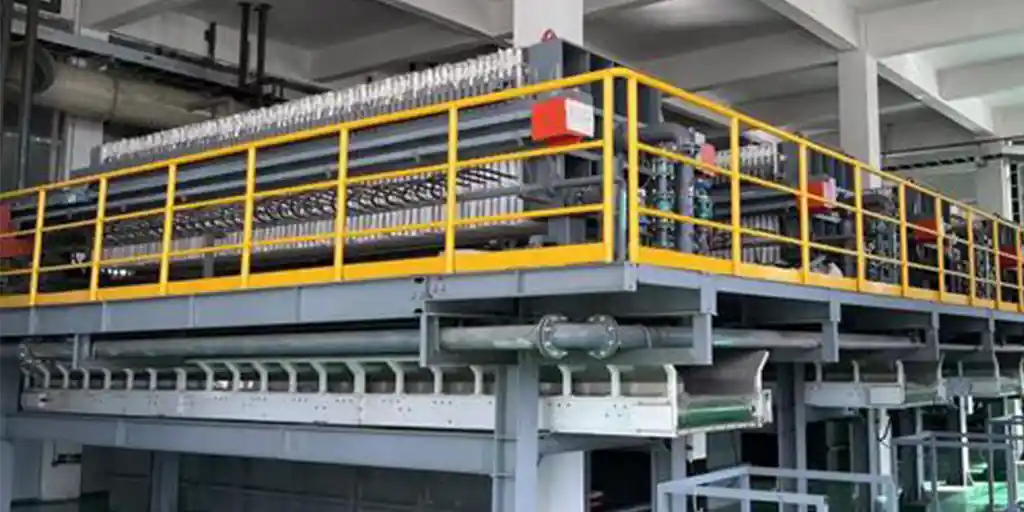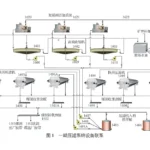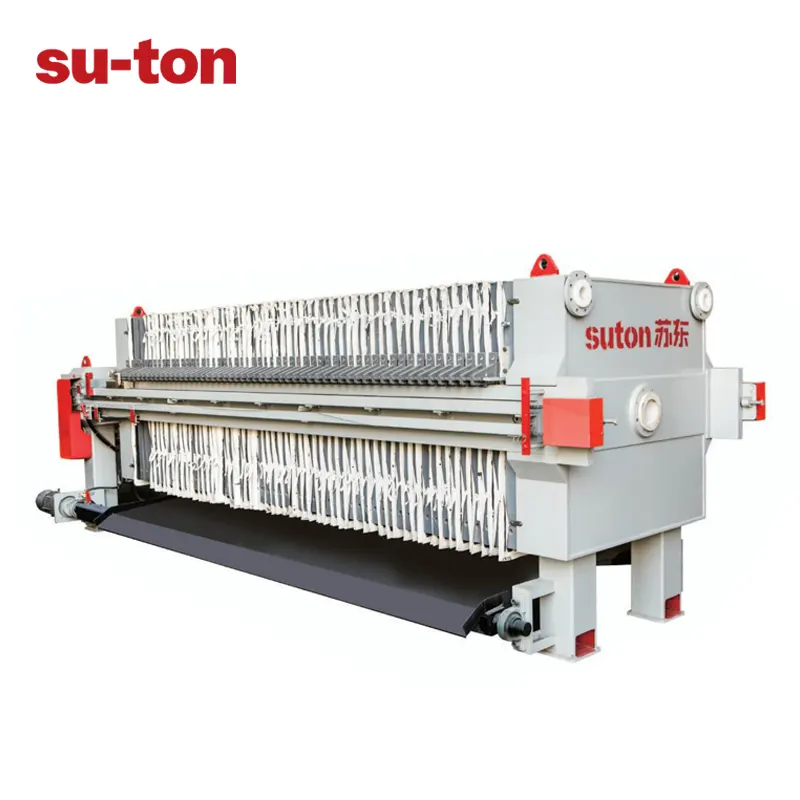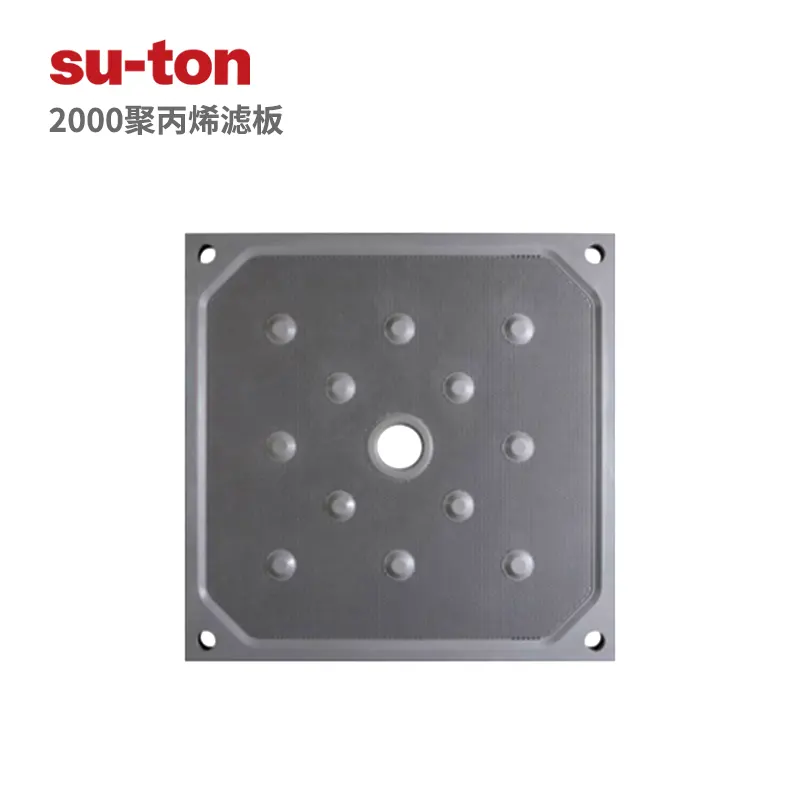1 Filter press working principle and structural characteristics
1.1 Principle of operation
filter pressIt mainly consists of transmission part, filter plate part, compression plate part, thrust plate part, compression device (mainly hydraulic compression device), hydraulic system, electric control system and auxiliary parts. Filter cloth is mounted on both sides of the filter plate, under the action of the compression device, the filter plate is pressed between the compression plate and thrust plate, and a closed filter chamber is formed between every two filter plates, when the feed pump pumps the material into the filter chamber, under the feeding pressure, the liquid phase material is separated from the filtration hole through the filter cloth, and the solid-phase material stays in the filter chamber and gradually forms the filter cake, so as to realise the material solid-liquid two separations, and the feeding pump stops feeding, then the compression plate is loosened, and the cake is discharged, thus completing the process. After the feeding pump stops feeding, the pressure plate will be loosened and the filter cake will be unloaded, thus completing a working cycle.
1.2 Structural characteristics of XMZ-type filter presses
This type of filter press is more advanced than the traditional filter press:
The main beam structure adopts double compartment beam structure, which has high bending, tensile and torsion strength and light weight compared with the traditional filter press (compartment beam type or plate beam), which enhances the comprehensive performance of the main beam.

The filter plate pressing adopts double-drag plunger cylinder hydraulic system, which reduces the filter plate pressing time by more than double, and greatly improves the working efficiency of the filter press; the power of traditional filter press is 5kW, and the power of this filter press is 4kW, which has obvious energy-saving effect, and the hydraulic motor adopts the advanced cycloidal motor, which is light in weight, small in size, and reliable in operation.
The control system of this filter press is controlled by PLC programmable controller, at the same time, the text display can be configured according to the requirements, the controller and the text display communicate through RS485, and the text display shows the operation status, fault alarm, process time, cycle times, pressure and other data, and the upper and lower limits of the cylinder can be set at any time through the text display, so that the operation status of the filter press can be controlled in an intuitive and timely manner. Therefore, it can intuitively and timely grasp the operation of the filter press.
2Filter Press Maintenancemaintenance
Often keep the hydraulic system clean, to prevent debris immersion and cause failure.
The filter cloth should be kept flat during the filter press, no folds are allowed, and the filter cloth can be cleaned as appropriate.
Check the filter cloth frequently, and if there is any breakage or leakage, it should be replaced and mended in time. When sewing and mending the filter cloth, the broken leakage should be cut off, and then sewing and mending, in order to prevent overlapping on the sealing surface and increase the thickness of the filter cloth.
Regularly fill the bearings with grease, oil the drive chain and tracks, and remove dirt.
Regularly replenish and change the oil to the hydraulic system and clean the oil filter to ensure the normal operation of the hydraulic system.
When the oil temperature of the hydraulic system is lower than 10 fahrenheit, a heater can be used to increase the oil temperature.
3 Filter press work common faults and causes analysis solutions
3.1 Common Failures
Hydraulic system failure.
Electrical system failure.
Other faults.
3.2 Failure analysis
3.2.1 Failure analysis of the hydraulic system
Causes of insufficient flow in hydraulic systems and how to deal with them.
The oil pump does not discharge oil, service the oil pump.
Sequence valve set pressure is too low or spool is stuck in open position, service sequence valve.
Clogged oil filter, clean oil filter.
The oil level of the oil tank is too low, the oil pump sucks up the air, it should be replenished with oil.
Hydraulic oil viscosity is too large, difficult to absorb oil, should change the oil or improve the oil temperature.
Serious wear and tear of parts in the pump, internal leakage, pressure flow rate can not reach the rated value, overhaul or replace the oil pump.
Causes of insufficient system pressure and how to deal with it.
Faulty oil pump, service oil pump.
Relief valve malfunction, adjust or overhaul relief valve.
Any leaks should be fixed.
At the beginning of loosening the filter plate, the cylinder oil pipe shock vibration, the reason is that the one-way throttle valve throttle port is too large, should be closed small one-way throttle valve throttle port.
After the return of the compression plate, but can not be directly converted to pull the plate, in addition to electrical faults, mainly due to the cylinder air is not discharged, the head plate forward, the return proximity switch is in a state of disconnection, the treatment method is: loosen the bleeder screw, so that the cylinder piston reciprocating movement, exhaust air.
Pulling plate failure: Firstly, the pulling plate pressure is incorrect, adjust the pulling plate pressure is generally in 3-4MPa, and secondly, the pulling plate speed is too fast or too slow, the impact of the filter plate is too large or pulling the filter plate, this time should be adjusted to adjust the speed control valve, pulling a piece of the filter plate time is about 7-10 seconds.
3.2.2 Electrical fault analysis
Electrical failures occur because of loose wires, wrong wiring, inoperative or damaged components, loose bolts, touched or loose parts, non-corresponding circuits or oil circuits, improperly adjusted pressure relays, unadjusted adjustable components, resulting in internal disconnections, and so on.
The handling of electrical faults requires electrical personnel not only to be familiar with the electrical schematic diagram, the performance of electrical components, but also to understand the hydraulic schematic diagram, the control of the filter press and the power transmission relationship. According to the time of failure, in which work process, in which action occurs, to determine the fault in the region. For some easy to occur faults, to check first, can speed up the speed of troubleshooting, such as loose wires, pressure relay adjustment is not appropriate or damaged.
3.2.3 Other faults and analyses
Causes of slurry generation and treatment.
The sealing surface of the filter plate rim is caught in the cake and the filter cloth should be washed;
The filter cloth is damaged and fails to meet the sealing requirements, replace the filter cloth;
The feed concentration is too low. Appropriately increase the feed concentration to 500g/l..
Reasons for not making cakes and how to deal with them.
The feed size is too small, the previous process should be improved;
The feed size is too small, the material viscosity is big, the filtration performance is poor, should change the nature of the material (with the addition of such methods as flocculants to improve its filtration conditions).

Feeding concentration is too low, cake forming time is long, increase the feeding concentration.
The filter cloth is damaged too quickly because the feed size is too large, it should go into the previous process.
The reason for the black water coming out of the filtrate tube is that the filter cloth is torn and leaking or the filter cloth pressure ring is not installed tightly.
The filter plate is tilted because too much sludge is accumulated at the bottom of the plate, and the filter cloth should be cleaned.
concluding remarks
Through the filter press maintenance, maintenance and fault analysis and treatment, greatly improve the use of the filter press, thus playing an important role in the normal production of the coal washing plant, improve the efficiency of coal washing, and generate good economic benefits.
Technology: 18851718517
E-mail: suton@su-ton.com
 Plate and frame chamber diaphragm filter presses
Plate and frame chamber diaphragm filter presses






